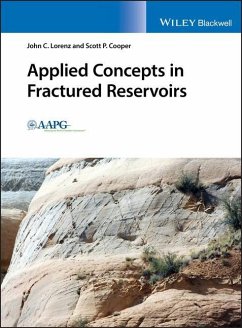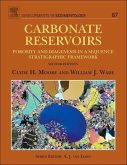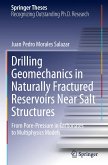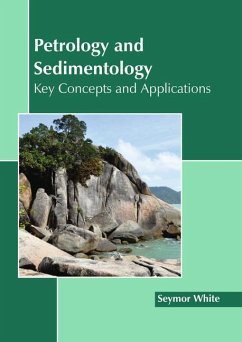Andere Kunden interessierten sich auch für
![Carbonate Reservoirs Carbonate Reservoirs]() Clyde H MooreCarbonate Reservoirs213,99 €
Clyde H MooreCarbonate Reservoirs213,99 €![Drilling Geomechanics in Naturally Fractured Reservoirs Near Salt Structures Drilling Geomechanics in Naturally Fractured Reservoirs Near Salt Structures]() Juan Pedro Morales SalazarDrilling Geomechanics in Naturally Fractured Reservoirs Near Salt Structures150,99 €
Juan Pedro Morales SalazarDrilling Geomechanics in Naturally Fractured Reservoirs Near Salt Structures150,99 €![Geoscience: Concepts and Applied Principles Geoscience: Concepts and Applied Principles]() Geoscience: Concepts and Applied Principles141,99 €
Geoscience: Concepts and Applied Principles141,99 €![Concepts and Applications of Earth Science Concepts and Applications of Earth Science]() Concepts and Applications of Earth Science148,99 €
Concepts and Applications of Earth Science148,99 €![Geoscience: Concepts and Applications Geoscience: Concepts and Applications]() Geoscience: Concepts and Applications154,99 €
Geoscience: Concepts and Applications154,99 €![Petrology and Sedimentology: Key Concepts and Applications Petrology and Sedimentology: Key Concepts and Applications]() Petrology and Sedimentology: Key Concepts and Applications155,99 €
Petrology and Sedimentology: Key Concepts and Applications155,99 €![Key Concepts in Geomorphology Key Concepts in Geomorphology]() Key Concepts in Geomorphology159,99 €
Key Concepts in Geomorphology159,99 €-
-
-
Produktdetails
- Verlag: Wiley
- Seitenzahl: 240
- Erscheinungstermin: 16. März 2020
- Englisch
- Abmessung: 282mm x 216mm x 18mm
- Gewicht: 953g
- ISBN-13: 9781119055860
- ISBN-10: 1119055865
- Artikelnr.: 57824787
Hinweis: Dieser Artikel kann nur an eine deutsche Lieferadresse ausgeliefert werden.
- Herstellerkennzeichnung
- Libri GmbH
- Europaallee 1
- 36244 Bad Hersfeld
- gpsr@libri.de
John C. Lorenz and Scott P. Cooper, are Senior Geologists at FractureStudies LLC, in Edgewood, NM.
Foreword xi
Preface xiii
Acknowledgements xv
Introduction xvii
Part 1 Understanding Natural Fractures: Fracture Types, Dimensions, and
Origin 1
1.1 Introduction 1
1.2 Nomenclature and Fracture-Classification Systems 1
1.2.1 Introduction 1
1.2.2 Other Classification Systems 3
1.2.3 Classifications for Fractures in Outcrops and Cores 4
1.2.4 Expulsion Fractures and Natural Hydraulic Fractures 5
1.2.5 Other Fracture Terminology 5
1.2.6 Sets, Systems, Domains, and Systematic Fractures 7
1.3 Fracture Characteristics and Dimensions 8
1.3.1 Introduction 8
1.3.2 Fracture Distribution Patterns 8
1.3.3 Fractography 10
1.3.4 Fracture Dip Angles 13
1.3.5 Fracture Distributions 13
1.3.6 Fracture Heights and Terminations 16
1.3.7 Fracture Lengths 18
1.3.8 Fracture Widths, Apertures, and Mineralization 19
1.3.9 Fracture Spacing 22
1.3.10 Fracture Strike 27
1.3.10.1 Fracture Orientations Relative to the In Situ Stresses 28
1.3.11 Discussion 28
1.4 The Mechanics of Fracturing Rock in Extension and Shear 29
1.4.1 Introduction 29
1.4.2 Origins of Geologic Stress Systems 31
1.4.2.1 Stresses in a Tectonically Quiescent Basin 31
1.4.2.2 Other Potential Sources of Horizontally Isotropic Stress 32
1.4.2.3 Stresses in a Tectonically Active Basin 32
1.4.3 Rock Susceptibility to Fracture: Basic Concepts 35
1.4.3.1 Introduction 35
1.4.3.2 Intrinsic Controls on Fracture Susceptibility 38
1.4.3.3 Extrinsic Controls on Fracture Susceptibility 39
1.4.3.4 How Rock Breaks: Grain-Scale Cracking, Yield, and Failure 41
1.4.3.5 Extrapolation to the Subsurface 43
1.4.4 Interplay Between Developing Fractures and the In Situ Stresses 44
1.4.5 The Importance of Pore Pressure 45
1.4.5.1 Introduction 45
1.4.5.2 The Relationship between Pore Pressure and Stress 45
1.4.5.3 Biot's Coefficient 47
1.4.5.4 Mohr Diagrams and Pore Pressure 47
1.4.5.5 Pore Pressure Makes Rock Weak and Brittle 47
1.4.5.6 Sources of Pore Pressure 50
1.4.5.7 Alternate Theories 51
1.4.6 Summary 52
1.5 Other Fracture Types 53
1.5.1 Introduction 53
1.5.2 Deformation-Band Shear Fractures, Compaction Bands, and Dilation
Bands 53
1.5.2.1 General Characteristics 53
1.5.2.2 Dimensions and Distributions 53
1.5.2.3 Origin 54
1.5.3 Faults and Fractures 55
1.5.4 Microfractures 56
1.5.5 Stylolites and Associated Extension Fractures 59
1.5.6 Bed-Parallel Shear Fractures 59
1.5.7 Beef-Filled Fractures 62
1.5.8 Ptygmatically Folded Fractures 63
1.5.9 Alteration of Fracture Systems by Dissolution 64
Appendix 1.A The Relationship Between Pore Pressure and the In Situ
Effective Stresses 66
Introduction 66
Vertical Stress 67
Horizontal Stress 67
Effective Vertical Stress 67
Effective Horizontal Stress 68
Stress Differential 68
Part 2 Measuring and Analyzing Fractures in Reservoirs 71
2.1 Introduction 71
2.1.1 Reasons to Take Core 72
2.1.2 Analyses 73
2.1.3 Fracture Data Sources 73
2.1.4 Quantitative vs. Semi-Quantitative Data 73
2.1.5 Timing of a Fracture Study 73
2.1.6 Need for Experience 74
2.1.7 Other Data Sources 74
2.2 Planning a Core Program for Fracture Analysis 74
2.2.1 Introduction 74
2.2.2 Core Diameter and Length 74
2.2.3 Substituting Sidewall Core Samples 74
2.2.4 Orienting a Core 74
2.2.5 Drilling Parameters 75
2.2.6 Trip Time for Core Recovery 75
2.2.7 Collecting Data on Site 75
2.2.8 Running an Image Log 76
2.2.9 Back-to-Back Cores 76
2.2.10 On-Site Processing 76
2.2.11 CT Scans 77
2.2.12 Removing Core from the Barrel 77
2.2.13 Core-Jam Prevention Measures 77
2.2.14 Maximizing and Documenting Core Continuity 77
2.2.15 Slabbing Protocol 77
2.2.16 Scheduling Fracture Logging and other Core Processes 78
2.3 Logging Core for Fractures 78
2.3.1 Wash the Core! 78
2.3.2 Use all the Core and Remove it from the Core Boxes 79
2.3.3 Laying Out Intervals of Core for Fracture Logging 79
2.3.4 Core-Logging Toolkit 80
2.3.5 Recording Data 81
2.3.6 Making and Using a Master Orientation Line 82
2.3.7 Differentiating Natural from Induced Fractures 83
2.4 Taking, Measuring and Analyzing Fracture Data 84
2.4.1 Fracture Type 84
2.4.2 Fracture Depths: Intensity and Density 86
2.4.3 Fracture Dip Angles 88
2.4.3.1 Measuring Dip Angles 88
2.4.3.2 Using Dip Angles 89
2.4.4 Fracture Distributions 90
2.4.5 Fracture Heights and Terminations 91
2.4.6 Fracture Widths, Apertures, and Mineralization 94
2.4.7 Fracture Spacings 98
2.4.7.1 Spacings from Horizontal Core 99
2.4.7.2 Spacings from Vertical Core 103
2.4.7.3 Converting Vertical Observations to Horizontal Fracture Spacings
103
2.4.7.4 Spacings of Inclined and Shear Fractures 105
2.4.7.5 Uses of Spacings 105
2.4.8 Measuring and Using Fracture Strikes 105
2.4.8.1 Measuring Fracture Strikes in Vertical Core 106
2.4.8.2 Measuring Fracture Strikes in Deviated or Horizontal Cores 109
2.5 New Core vs. Archived Core 110
2.6 Oriented Core 112
2.6.1 Other Ways of Orienting a Core 116
2.7 Using CT Scans 118
2.8 Fracture Data from Image Logs 119
2.9 Comparing Fracture Data from Outcrops, Core, and Logs 122
2.9.1 Introduction 122
2.9.2 Large-Scale Outcrop Studies 123
2.9.3 Local Outcrop Studies 123
2.9.3.1 Raton Basin 123
2.9.3.2 Rifle Gap 125
2.9.3.3 San Ysidro 127
2.10 Fracture Data from 3D Seismic Surveys 128
2.11 Fracture Data Acquired by LiDAR 130
2.12 Fracture Data from Engineering Tests 132
2.13 Case Studies in Estimating Fracture Effectiveness from Core 133
2.13.1 Introduction 133
2.13.2 Case Study 1: Archived Vertical, Unoriented Core 133
2.13.3 Case Study 2: New, Un-Slabbed Horizontal Core 134
2.13.3.1 Introduction 134
2.13.3.2 Fracture Effectiveness 137
2.13.3.3 System Effectiveness and Permeability Anisotropy 137
2.13.4 Case Study 3: New, Slabbed, Vertical Core 139
2.13.4.1 Introduction 139
2.13.4.2 Calculating Effectiveness 139
2.13.4.3 Description of the High-Angle Extension Fractures 141
Appendix 2.A Workflow and List of Tests, Data 144
Appendix 2.B Core-Handling, Marking, Sampling, and Analysis Protocol for
Core Studies Focused on Natural Fractures 144
Appendix 2.C Slabbing Recommendations for Horizontal Core 146
Part 3 Effects of Natural Fractures on Reservoirs 149
3.1 Introduction 149
3.2 Classification 149
3.3 The Permeability Behavior of Individual Fractures 150
3.3.1 Introduction 150
3.3.2 Three Categories of Fracture Effects 150
3.3.3 Stylolites 154
3.3.4 Microfractures 154
3.4 The Effects of Fracture Systems 156
3.4.1 Introduction 156
3.4.2 Fracture-Controlled Permeability Anisotropy 157
3.4.2.1 Case Study: The Midale Field 157
3.4.2.2 Case Study: The Rulison Field 158
3.4.2.3 Case Study: The Spraberry Formation 158
3.4.3 Fracture-Controlled Sweet Spots 162
3.5 The Sensitivity of Fracture Permeability to Changing Stress 164
3.5.1 Stress-Sensitive Extension Fractures 164
3.5.1.1 Case Study: The Bulo Bulo Field 167
3.5.2 Stress-Sensitive Shear Fractures 169
3.5.3 Damage Due to Production-Related Scale 171
3.6 Fracture Volumetrics 172
3.6.1 Introduction 172
3.6.2 Fracture Volume/Fracture Porosity 173
3.6.3 Fracture Permeability 174
3.6.4 Transfer Function 176
3.6.5 Fracture Surface Areas 176
3.7 Effects of Fractures on Drilling and Coring 177
3.8 Completions: The Interaction Between Natural and Hydraulic Fractures
178
3.8.1 Early Conceptual Models 178
3.8.2 Direct Evidence of the Characteristics of Hydraulic Fractures 179
3.8.3 The Developing Hydraulic-Fracture Model 182
3.8.4 Nuclear Stimulations 184
References 187
Index 205
Preface xiii
Acknowledgements xv
Introduction xvii
Part 1 Understanding Natural Fractures: Fracture Types, Dimensions, and
Origin 1
1.1 Introduction 1
1.2 Nomenclature and Fracture-Classification Systems 1
1.2.1 Introduction 1
1.2.2 Other Classification Systems 3
1.2.3 Classifications for Fractures in Outcrops and Cores 4
1.2.4 Expulsion Fractures and Natural Hydraulic Fractures 5
1.2.5 Other Fracture Terminology 5
1.2.6 Sets, Systems, Domains, and Systematic Fractures 7
1.3 Fracture Characteristics and Dimensions 8
1.3.1 Introduction 8
1.3.2 Fracture Distribution Patterns 8
1.3.3 Fractography 10
1.3.4 Fracture Dip Angles 13
1.3.5 Fracture Distributions 13
1.3.6 Fracture Heights and Terminations 16
1.3.7 Fracture Lengths 18
1.3.8 Fracture Widths, Apertures, and Mineralization 19
1.3.9 Fracture Spacing 22
1.3.10 Fracture Strike 27
1.3.10.1 Fracture Orientations Relative to the In Situ Stresses 28
1.3.11 Discussion 28
1.4 The Mechanics of Fracturing Rock in Extension and Shear 29
1.4.1 Introduction 29
1.4.2 Origins of Geologic Stress Systems 31
1.4.2.1 Stresses in a Tectonically Quiescent Basin 31
1.4.2.2 Other Potential Sources of Horizontally Isotropic Stress 32
1.4.2.3 Stresses in a Tectonically Active Basin 32
1.4.3 Rock Susceptibility to Fracture: Basic Concepts 35
1.4.3.1 Introduction 35
1.4.3.2 Intrinsic Controls on Fracture Susceptibility 38
1.4.3.3 Extrinsic Controls on Fracture Susceptibility 39
1.4.3.4 How Rock Breaks: Grain-Scale Cracking, Yield, and Failure 41
1.4.3.5 Extrapolation to the Subsurface 43
1.4.4 Interplay Between Developing Fractures and the In Situ Stresses 44
1.4.5 The Importance of Pore Pressure 45
1.4.5.1 Introduction 45
1.4.5.2 The Relationship between Pore Pressure and Stress 45
1.4.5.3 Biot's Coefficient 47
1.4.5.4 Mohr Diagrams and Pore Pressure 47
1.4.5.5 Pore Pressure Makes Rock Weak and Brittle 47
1.4.5.6 Sources of Pore Pressure 50
1.4.5.7 Alternate Theories 51
1.4.6 Summary 52
1.5 Other Fracture Types 53
1.5.1 Introduction 53
1.5.2 Deformation-Band Shear Fractures, Compaction Bands, and Dilation
Bands 53
1.5.2.1 General Characteristics 53
1.5.2.2 Dimensions and Distributions 53
1.5.2.3 Origin 54
1.5.3 Faults and Fractures 55
1.5.4 Microfractures 56
1.5.5 Stylolites and Associated Extension Fractures 59
1.5.6 Bed-Parallel Shear Fractures 59
1.5.7 Beef-Filled Fractures 62
1.5.8 Ptygmatically Folded Fractures 63
1.5.9 Alteration of Fracture Systems by Dissolution 64
Appendix 1.A The Relationship Between Pore Pressure and the In Situ
Effective Stresses 66
Introduction 66
Vertical Stress 67
Horizontal Stress 67
Effective Vertical Stress 67
Effective Horizontal Stress 68
Stress Differential 68
Part 2 Measuring and Analyzing Fractures in Reservoirs 71
2.1 Introduction 71
2.1.1 Reasons to Take Core 72
2.1.2 Analyses 73
2.1.3 Fracture Data Sources 73
2.1.4 Quantitative vs. Semi-Quantitative Data 73
2.1.5 Timing of a Fracture Study 73
2.1.6 Need for Experience 74
2.1.7 Other Data Sources 74
2.2 Planning a Core Program for Fracture Analysis 74
2.2.1 Introduction 74
2.2.2 Core Diameter and Length 74
2.2.3 Substituting Sidewall Core Samples 74
2.2.4 Orienting a Core 74
2.2.5 Drilling Parameters 75
2.2.6 Trip Time for Core Recovery 75
2.2.7 Collecting Data on Site 75
2.2.8 Running an Image Log 76
2.2.9 Back-to-Back Cores 76
2.2.10 On-Site Processing 76
2.2.11 CT Scans 77
2.2.12 Removing Core from the Barrel 77
2.2.13 Core-Jam Prevention Measures 77
2.2.14 Maximizing and Documenting Core Continuity 77
2.2.15 Slabbing Protocol 77
2.2.16 Scheduling Fracture Logging and other Core Processes 78
2.3 Logging Core for Fractures 78
2.3.1 Wash the Core! 78
2.3.2 Use all the Core and Remove it from the Core Boxes 79
2.3.3 Laying Out Intervals of Core for Fracture Logging 79
2.3.4 Core-Logging Toolkit 80
2.3.5 Recording Data 81
2.3.6 Making and Using a Master Orientation Line 82
2.3.7 Differentiating Natural from Induced Fractures 83
2.4 Taking, Measuring and Analyzing Fracture Data 84
2.4.1 Fracture Type 84
2.4.2 Fracture Depths: Intensity and Density 86
2.4.3 Fracture Dip Angles 88
2.4.3.1 Measuring Dip Angles 88
2.4.3.2 Using Dip Angles 89
2.4.4 Fracture Distributions 90
2.4.5 Fracture Heights and Terminations 91
2.4.6 Fracture Widths, Apertures, and Mineralization 94
2.4.7 Fracture Spacings 98
2.4.7.1 Spacings from Horizontal Core 99
2.4.7.2 Spacings from Vertical Core 103
2.4.7.3 Converting Vertical Observations to Horizontal Fracture Spacings
103
2.4.7.4 Spacings of Inclined and Shear Fractures 105
2.4.7.5 Uses of Spacings 105
2.4.8 Measuring and Using Fracture Strikes 105
2.4.8.1 Measuring Fracture Strikes in Vertical Core 106
2.4.8.2 Measuring Fracture Strikes in Deviated or Horizontal Cores 109
2.5 New Core vs. Archived Core 110
2.6 Oriented Core 112
2.6.1 Other Ways of Orienting a Core 116
2.7 Using CT Scans 118
2.8 Fracture Data from Image Logs 119
2.9 Comparing Fracture Data from Outcrops, Core, and Logs 122
2.9.1 Introduction 122
2.9.2 Large-Scale Outcrop Studies 123
2.9.3 Local Outcrop Studies 123
2.9.3.1 Raton Basin 123
2.9.3.2 Rifle Gap 125
2.9.3.3 San Ysidro 127
2.10 Fracture Data from 3D Seismic Surveys 128
2.11 Fracture Data Acquired by LiDAR 130
2.12 Fracture Data from Engineering Tests 132
2.13 Case Studies in Estimating Fracture Effectiveness from Core 133
2.13.1 Introduction 133
2.13.2 Case Study 1: Archived Vertical, Unoriented Core 133
2.13.3 Case Study 2: New, Un-Slabbed Horizontal Core 134
2.13.3.1 Introduction 134
2.13.3.2 Fracture Effectiveness 137
2.13.3.3 System Effectiveness and Permeability Anisotropy 137
2.13.4 Case Study 3: New, Slabbed, Vertical Core 139
2.13.4.1 Introduction 139
2.13.4.2 Calculating Effectiveness 139
2.13.4.3 Description of the High-Angle Extension Fractures 141
Appendix 2.A Workflow and List of Tests, Data 144
Appendix 2.B Core-Handling, Marking, Sampling, and Analysis Protocol for
Core Studies Focused on Natural Fractures 144
Appendix 2.C Slabbing Recommendations for Horizontal Core 146
Part 3 Effects of Natural Fractures on Reservoirs 149
3.1 Introduction 149
3.2 Classification 149
3.3 The Permeability Behavior of Individual Fractures 150
3.3.1 Introduction 150
3.3.2 Three Categories of Fracture Effects 150
3.3.3 Stylolites 154
3.3.4 Microfractures 154
3.4 The Effects of Fracture Systems 156
3.4.1 Introduction 156
3.4.2 Fracture-Controlled Permeability Anisotropy 157
3.4.2.1 Case Study: The Midale Field 157
3.4.2.2 Case Study: The Rulison Field 158
3.4.2.3 Case Study: The Spraberry Formation 158
3.4.3 Fracture-Controlled Sweet Spots 162
3.5 The Sensitivity of Fracture Permeability to Changing Stress 164
3.5.1 Stress-Sensitive Extension Fractures 164
3.5.1.1 Case Study: The Bulo Bulo Field 167
3.5.2 Stress-Sensitive Shear Fractures 169
3.5.3 Damage Due to Production-Related Scale 171
3.6 Fracture Volumetrics 172
3.6.1 Introduction 172
3.6.2 Fracture Volume/Fracture Porosity 173
3.6.3 Fracture Permeability 174
3.6.4 Transfer Function 176
3.6.5 Fracture Surface Areas 176
3.7 Effects of Fractures on Drilling and Coring 177
3.8 Completions: The Interaction Between Natural and Hydraulic Fractures
178
3.8.1 Early Conceptual Models 178
3.8.2 Direct Evidence of the Characteristics of Hydraulic Fractures 179
3.8.3 The Developing Hydraulic-Fracture Model 182
3.8.4 Nuclear Stimulations 184
References 187
Index 205
Foreword xi
Preface xiii
Acknowledgements xv
Introduction xvii
Part 1 Understanding Natural Fractures: Fracture Types, Dimensions, and
Origin 1
1.1 Introduction 1
1.2 Nomenclature and Fracture-Classification Systems 1
1.2.1 Introduction 1
1.2.2 Other Classification Systems 3
1.2.3 Classifications for Fractures in Outcrops and Cores 4
1.2.4 Expulsion Fractures and Natural Hydraulic Fractures 5
1.2.5 Other Fracture Terminology 5
1.2.6 Sets, Systems, Domains, and Systematic Fractures 7
1.3 Fracture Characteristics and Dimensions 8
1.3.1 Introduction 8
1.3.2 Fracture Distribution Patterns 8
1.3.3 Fractography 10
1.3.4 Fracture Dip Angles 13
1.3.5 Fracture Distributions 13
1.3.6 Fracture Heights and Terminations 16
1.3.7 Fracture Lengths 18
1.3.8 Fracture Widths, Apertures, and Mineralization 19
1.3.9 Fracture Spacing 22
1.3.10 Fracture Strike 27
1.3.10.1 Fracture Orientations Relative to the In Situ Stresses 28
1.3.11 Discussion 28
1.4 The Mechanics of Fracturing Rock in Extension and Shear 29
1.4.1 Introduction 29
1.4.2 Origins of Geologic Stress Systems 31
1.4.2.1 Stresses in a Tectonically Quiescent Basin 31
1.4.2.2 Other Potential Sources of Horizontally Isotropic Stress 32
1.4.2.3 Stresses in a Tectonically Active Basin 32
1.4.3 Rock Susceptibility to Fracture: Basic Concepts 35
1.4.3.1 Introduction 35
1.4.3.2 Intrinsic Controls on Fracture Susceptibility 38
1.4.3.3 Extrinsic Controls on Fracture Susceptibility 39
1.4.3.4 How Rock Breaks: Grain-Scale Cracking, Yield, and Failure 41
1.4.3.5 Extrapolation to the Subsurface 43
1.4.4 Interplay Between Developing Fractures and the In Situ Stresses 44
1.4.5 The Importance of Pore Pressure 45
1.4.5.1 Introduction 45
1.4.5.2 The Relationship between Pore Pressure and Stress 45
1.4.5.3 Biot's Coefficient 47
1.4.5.4 Mohr Diagrams and Pore Pressure 47
1.4.5.5 Pore Pressure Makes Rock Weak and Brittle 47
1.4.5.6 Sources of Pore Pressure 50
1.4.5.7 Alternate Theories 51
1.4.6 Summary 52
1.5 Other Fracture Types 53
1.5.1 Introduction 53
1.5.2 Deformation-Band Shear Fractures, Compaction Bands, and Dilation
Bands 53
1.5.2.1 General Characteristics 53
1.5.2.2 Dimensions and Distributions 53
1.5.2.3 Origin 54
1.5.3 Faults and Fractures 55
1.5.4 Microfractures 56
1.5.5 Stylolites and Associated Extension Fractures 59
1.5.6 Bed-Parallel Shear Fractures 59
1.5.7 Beef-Filled Fractures 62
1.5.8 Ptygmatically Folded Fractures 63
1.5.9 Alteration of Fracture Systems by Dissolution 64
Appendix 1.A The Relationship Between Pore Pressure and the In Situ
Effective Stresses 66
Introduction 66
Vertical Stress 67
Horizontal Stress 67
Effective Vertical Stress 67
Effective Horizontal Stress 68
Stress Differential 68
Part 2 Measuring and Analyzing Fractures in Reservoirs 71
2.1 Introduction 71
2.1.1 Reasons to Take Core 72
2.1.2 Analyses 73
2.1.3 Fracture Data Sources 73
2.1.4 Quantitative vs. Semi-Quantitative Data 73
2.1.5 Timing of a Fracture Study 73
2.1.6 Need for Experience 74
2.1.7 Other Data Sources 74
2.2 Planning a Core Program for Fracture Analysis 74
2.2.1 Introduction 74
2.2.2 Core Diameter and Length 74
2.2.3 Substituting Sidewall Core Samples 74
2.2.4 Orienting a Core 74
2.2.5 Drilling Parameters 75
2.2.6 Trip Time for Core Recovery 75
2.2.7 Collecting Data on Site 75
2.2.8 Running an Image Log 76
2.2.9 Back-to-Back Cores 76
2.2.10 On-Site Processing 76
2.2.11 CT Scans 77
2.2.12 Removing Core from the Barrel 77
2.2.13 Core-Jam Prevention Measures 77
2.2.14 Maximizing and Documenting Core Continuity 77
2.2.15 Slabbing Protocol 77
2.2.16 Scheduling Fracture Logging and other Core Processes 78
2.3 Logging Core for Fractures 78
2.3.1 Wash the Core! 78
2.3.2 Use all the Core and Remove it from the Core Boxes 79
2.3.3 Laying Out Intervals of Core for Fracture Logging 79
2.3.4 Core-Logging Toolkit 80
2.3.5 Recording Data 81
2.3.6 Making and Using a Master Orientation Line 82
2.3.7 Differentiating Natural from Induced Fractures 83
2.4 Taking, Measuring and Analyzing Fracture Data 84
2.4.1 Fracture Type 84
2.4.2 Fracture Depths: Intensity and Density 86
2.4.3 Fracture Dip Angles 88
2.4.3.1 Measuring Dip Angles 88
2.4.3.2 Using Dip Angles 89
2.4.4 Fracture Distributions 90
2.4.5 Fracture Heights and Terminations 91
2.4.6 Fracture Widths, Apertures, and Mineralization 94
2.4.7 Fracture Spacings 98
2.4.7.1 Spacings from Horizontal Core 99
2.4.7.2 Spacings from Vertical Core 103
2.4.7.3 Converting Vertical Observations to Horizontal Fracture Spacings
103
2.4.7.4 Spacings of Inclined and Shear Fractures 105
2.4.7.5 Uses of Spacings 105
2.4.8 Measuring and Using Fracture Strikes 105
2.4.8.1 Measuring Fracture Strikes in Vertical Core 106
2.4.8.2 Measuring Fracture Strikes in Deviated or Horizontal Cores 109
2.5 New Core vs. Archived Core 110
2.6 Oriented Core 112
2.6.1 Other Ways of Orienting a Core 116
2.7 Using CT Scans 118
2.8 Fracture Data from Image Logs 119
2.9 Comparing Fracture Data from Outcrops, Core, and Logs 122
2.9.1 Introduction 122
2.9.2 Large-Scale Outcrop Studies 123
2.9.3 Local Outcrop Studies 123
2.9.3.1 Raton Basin 123
2.9.3.2 Rifle Gap 125
2.9.3.3 San Ysidro 127
2.10 Fracture Data from 3D Seismic Surveys 128
2.11 Fracture Data Acquired by LiDAR 130
2.12 Fracture Data from Engineering Tests 132
2.13 Case Studies in Estimating Fracture Effectiveness from Core 133
2.13.1 Introduction 133
2.13.2 Case Study 1: Archived Vertical, Unoriented Core 133
2.13.3 Case Study 2: New, Un-Slabbed Horizontal Core 134
2.13.3.1 Introduction 134
2.13.3.2 Fracture Effectiveness 137
2.13.3.3 System Effectiveness and Permeability Anisotropy 137
2.13.4 Case Study 3: New, Slabbed, Vertical Core 139
2.13.4.1 Introduction 139
2.13.4.2 Calculating Effectiveness 139
2.13.4.3 Description of the High-Angle Extension Fractures 141
Appendix 2.A Workflow and List of Tests, Data 144
Appendix 2.B Core-Handling, Marking, Sampling, and Analysis Protocol for
Core Studies Focused on Natural Fractures 144
Appendix 2.C Slabbing Recommendations for Horizontal Core 146
Part 3 Effects of Natural Fractures on Reservoirs 149
3.1 Introduction 149
3.2 Classification 149
3.3 The Permeability Behavior of Individual Fractures 150
3.3.1 Introduction 150
3.3.2 Three Categories of Fracture Effects 150
3.3.3 Stylolites 154
3.3.4 Microfractures 154
3.4 The Effects of Fracture Systems 156
3.4.1 Introduction 156
3.4.2 Fracture-Controlled Permeability Anisotropy 157
3.4.2.1 Case Study: The Midale Field 157
3.4.2.2 Case Study: The Rulison Field 158
3.4.2.3 Case Study: The Spraberry Formation 158
3.4.3 Fracture-Controlled Sweet Spots 162
3.5 The Sensitivity of Fracture Permeability to Changing Stress 164
3.5.1 Stress-Sensitive Extension Fractures 164
3.5.1.1 Case Study: The Bulo Bulo Field 167
3.5.2 Stress-Sensitive Shear Fractures 169
3.5.3 Damage Due to Production-Related Scale 171
3.6 Fracture Volumetrics 172
3.6.1 Introduction 172
3.6.2 Fracture Volume/Fracture Porosity 173
3.6.3 Fracture Permeability 174
3.6.4 Transfer Function 176
3.6.5 Fracture Surface Areas 176
3.7 Effects of Fractures on Drilling and Coring 177
3.8 Completions: The Interaction Between Natural and Hydraulic Fractures
178
3.8.1 Early Conceptual Models 178
3.8.2 Direct Evidence of the Characteristics of Hydraulic Fractures 179
3.8.3 The Developing Hydraulic-Fracture Model 182
3.8.4 Nuclear Stimulations 184
References 187
Index 205
Preface xiii
Acknowledgements xv
Introduction xvii
Part 1 Understanding Natural Fractures: Fracture Types, Dimensions, and
Origin 1
1.1 Introduction 1
1.2 Nomenclature and Fracture-Classification Systems 1
1.2.1 Introduction 1
1.2.2 Other Classification Systems 3
1.2.3 Classifications for Fractures in Outcrops and Cores 4
1.2.4 Expulsion Fractures and Natural Hydraulic Fractures 5
1.2.5 Other Fracture Terminology 5
1.2.6 Sets, Systems, Domains, and Systematic Fractures 7
1.3 Fracture Characteristics and Dimensions 8
1.3.1 Introduction 8
1.3.2 Fracture Distribution Patterns 8
1.3.3 Fractography 10
1.3.4 Fracture Dip Angles 13
1.3.5 Fracture Distributions 13
1.3.6 Fracture Heights and Terminations 16
1.3.7 Fracture Lengths 18
1.3.8 Fracture Widths, Apertures, and Mineralization 19
1.3.9 Fracture Spacing 22
1.3.10 Fracture Strike 27
1.3.10.1 Fracture Orientations Relative to the In Situ Stresses 28
1.3.11 Discussion 28
1.4 The Mechanics of Fracturing Rock in Extension and Shear 29
1.4.1 Introduction 29
1.4.2 Origins of Geologic Stress Systems 31
1.4.2.1 Stresses in a Tectonically Quiescent Basin 31
1.4.2.2 Other Potential Sources of Horizontally Isotropic Stress 32
1.4.2.3 Stresses in a Tectonically Active Basin 32
1.4.3 Rock Susceptibility to Fracture: Basic Concepts 35
1.4.3.1 Introduction 35
1.4.3.2 Intrinsic Controls on Fracture Susceptibility 38
1.4.3.3 Extrinsic Controls on Fracture Susceptibility 39
1.4.3.4 How Rock Breaks: Grain-Scale Cracking, Yield, and Failure 41
1.4.3.5 Extrapolation to the Subsurface 43
1.4.4 Interplay Between Developing Fractures and the In Situ Stresses 44
1.4.5 The Importance of Pore Pressure 45
1.4.5.1 Introduction 45
1.4.5.2 The Relationship between Pore Pressure and Stress 45
1.4.5.3 Biot's Coefficient 47
1.4.5.4 Mohr Diagrams and Pore Pressure 47
1.4.5.5 Pore Pressure Makes Rock Weak and Brittle 47
1.4.5.6 Sources of Pore Pressure 50
1.4.5.7 Alternate Theories 51
1.4.6 Summary 52
1.5 Other Fracture Types 53
1.5.1 Introduction 53
1.5.2 Deformation-Band Shear Fractures, Compaction Bands, and Dilation
Bands 53
1.5.2.1 General Characteristics 53
1.5.2.2 Dimensions and Distributions 53
1.5.2.3 Origin 54
1.5.3 Faults and Fractures 55
1.5.4 Microfractures 56
1.5.5 Stylolites and Associated Extension Fractures 59
1.5.6 Bed-Parallel Shear Fractures 59
1.5.7 Beef-Filled Fractures 62
1.5.8 Ptygmatically Folded Fractures 63
1.5.9 Alteration of Fracture Systems by Dissolution 64
Appendix 1.A The Relationship Between Pore Pressure and the In Situ
Effective Stresses 66
Introduction 66
Vertical Stress 67
Horizontal Stress 67
Effective Vertical Stress 67
Effective Horizontal Stress 68
Stress Differential 68
Part 2 Measuring and Analyzing Fractures in Reservoirs 71
2.1 Introduction 71
2.1.1 Reasons to Take Core 72
2.1.2 Analyses 73
2.1.3 Fracture Data Sources 73
2.1.4 Quantitative vs. Semi-Quantitative Data 73
2.1.5 Timing of a Fracture Study 73
2.1.6 Need for Experience 74
2.1.7 Other Data Sources 74
2.2 Planning a Core Program for Fracture Analysis 74
2.2.1 Introduction 74
2.2.2 Core Diameter and Length 74
2.2.3 Substituting Sidewall Core Samples 74
2.2.4 Orienting a Core 74
2.2.5 Drilling Parameters 75
2.2.6 Trip Time for Core Recovery 75
2.2.7 Collecting Data on Site 75
2.2.8 Running an Image Log 76
2.2.9 Back-to-Back Cores 76
2.2.10 On-Site Processing 76
2.2.11 CT Scans 77
2.2.12 Removing Core from the Barrel 77
2.2.13 Core-Jam Prevention Measures 77
2.2.14 Maximizing and Documenting Core Continuity 77
2.2.15 Slabbing Protocol 77
2.2.16 Scheduling Fracture Logging and other Core Processes 78
2.3 Logging Core for Fractures 78
2.3.1 Wash the Core! 78
2.3.2 Use all the Core and Remove it from the Core Boxes 79
2.3.3 Laying Out Intervals of Core for Fracture Logging 79
2.3.4 Core-Logging Toolkit 80
2.3.5 Recording Data 81
2.3.6 Making and Using a Master Orientation Line 82
2.3.7 Differentiating Natural from Induced Fractures 83
2.4 Taking, Measuring and Analyzing Fracture Data 84
2.4.1 Fracture Type 84
2.4.2 Fracture Depths: Intensity and Density 86
2.4.3 Fracture Dip Angles 88
2.4.3.1 Measuring Dip Angles 88
2.4.3.2 Using Dip Angles 89
2.4.4 Fracture Distributions 90
2.4.5 Fracture Heights and Terminations 91
2.4.6 Fracture Widths, Apertures, and Mineralization 94
2.4.7 Fracture Spacings 98
2.4.7.1 Spacings from Horizontal Core 99
2.4.7.2 Spacings from Vertical Core 103
2.4.7.3 Converting Vertical Observations to Horizontal Fracture Spacings
103
2.4.7.4 Spacings of Inclined and Shear Fractures 105
2.4.7.5 Uses of Spacings 105
2.4.8 Measuring and Using Fracture Strikes 105
2.4.8.1 Measuring Fracture Strikes in Vertical Core 106
2.4.8.2 Measuring Fracture Strikes in Deviated or Horizontal Cores 109
2.5 New Core vs. Archived Core 110
2.6 Oriented Core 112
2.6.1 Other Ways of Orienting a Core 116
2.7 Using CT Scans 118
2.8 Fracture Data from Image Logs 119
2.9 Comparing Fracture Data from Outcrops, Core, and Logs 122
2.9.1 Introduction 122
2.9.2 Large-Scale Outcrop Studies 123
2.9.3 Local Outcrop Studies 123
2.9.3.1 Raton Basin 123
2.9.3.2 Rifle Gap 125
2.9.3.3 San Ysidro 127
2.10 Fracture Data from 3D Seismic Surveys 128
2.11 Fracture Data Acquired by LiDAR 130
2.12 Fracture Data from Engineering Tests 132
2.13 Case Studies in Estimating Fracture Effectiveness from Core 133
2.13.1 Introduction 133
2.13.2 Case Study 1: Archived Vertical, Unoriented Core 133
2.13.3 Case Study 2: New, Un-Slabbed Horizontal Core 134
2.13.3.1 Introduction 134
2.13.3.2 Fracture Effectiveness 137
2.13.3.3 System Effectiveness and Permeability Anisotropy 137
2.13.4 Case Study 3: New, Slabbed, Vertical Core 139
2.13.4.1 Introduction 139
2.13.4.2 Calculating Effectiveness 139
2.13.4.3 Description of the High-Angle Extension Fractures 141
Appendix 2.A Workflow and List of Tests, Data 144
Appendix 2.B Core-Handling, Marking, Sampling, and Analysis Protocol for
Core Studies Focused on Natural Fractures 144
Appendix 2.C Slabbing Recommendations for Horizontal Core 146
Part 3 Effects of Natural Fractures on Reservoirs 149
3.1 Introduction 149
3.2 Classification 149
3.3 The Permeability Behavior of Individual Fractures 150
3.3.1 Introduction 150
3.3.2 Three Categories of Fracture Effects 150
3.3.3 Stylolites 154
3.3.4 Microfractures 154
3.4 The Effects of Fracture Systems 156
3.4.1 Introduction 156
3.4.2 Fracture-Controlled Permeability Anisotropy 157
3.4.2.1 Case Study: The Midale Field 157
3.4.2.2 Case Study: The Rulison Field 158
3.4.2.3 Case Study: The Spraberry Formation 158
3.4.3 Fracture-Controlled Sweet Spots 162
3.5 The Sensitivity of Fracture Permeability to Changing Stress 164
3.5.1 Stress-Sensitive Extension Fractures 164
3.5.1.1 Case Study: The Bulo Bulo Field 167
3.5.2 Stress-Sensitive Shear Fractures 169
3.5.3 Damage Due to Production-Related Scale 171
3.6 Fracture Volumetrics 172
3.6.1 Introduction 172
3.6.2 Fracture Volume/Fracture Porosity 173
3.6.3 Fracture Permeability 174
3.6.4 Transfer Function 176
3.6.5 Fracture Surface Areas 176
3.7 Effects of Fractures on Drilling and Coring 177
3.8 Completions: The Interaction Between Natural and Hydraulic Fractures
178
3.8.1 Early Conceptual Models 178
3.8.2 Direct Evidence of the Characteristics of Hydraulic Fractures 179
3.8.3 The Developing Hydraulic-Fracture Model 182
3.8.4 Nuclear Stimulations 184
References 187
Index 205








